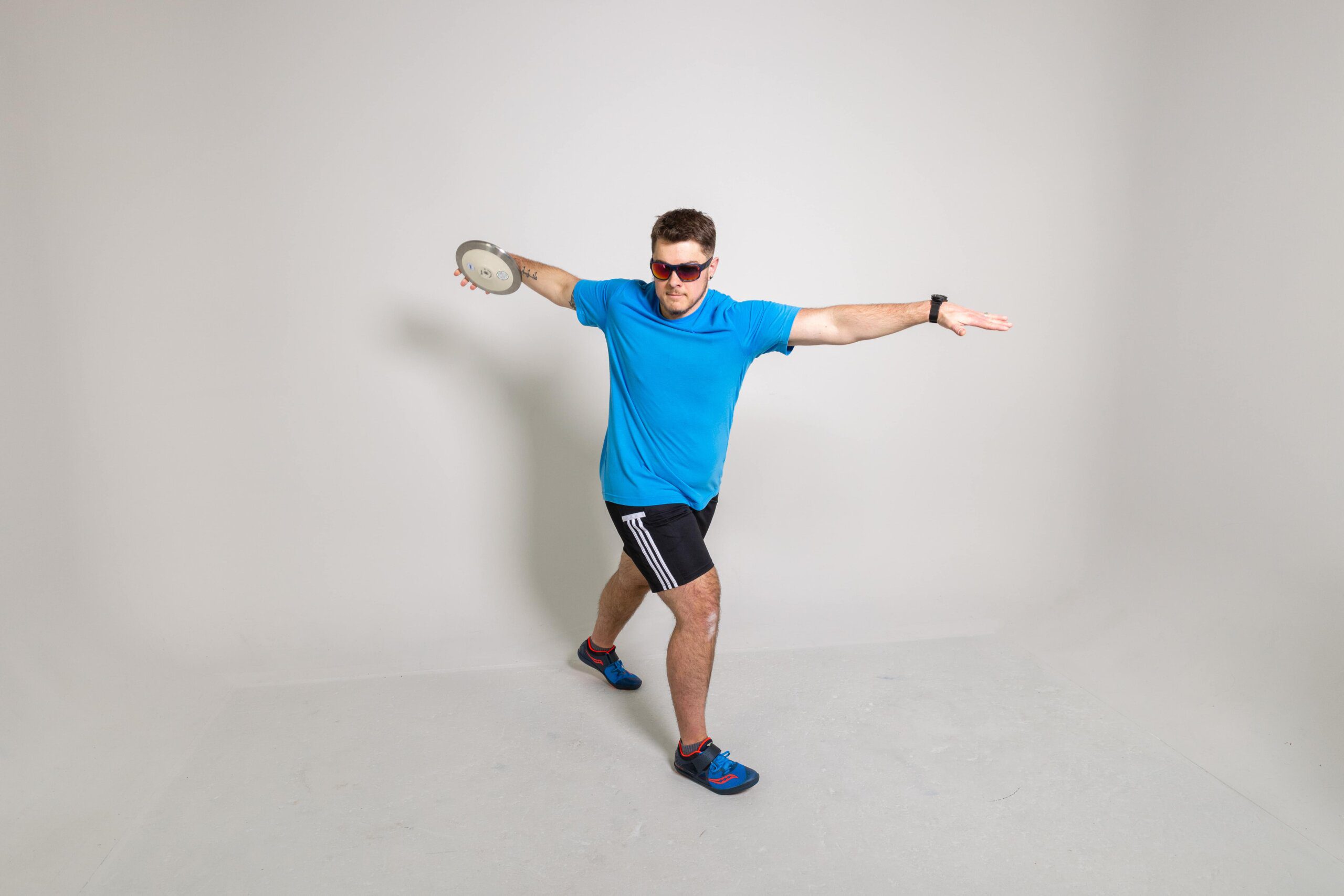It was a quiet May morning in Lethbridge, Alberta, when Ness Murby made history.
Stepping onto the sun-scorched field in front of a handful of spectators, two-kilogram discus in hand, Murby became the first openly trans Paralympian man in competition.
“I was so filled with pride to be showing up as my authentic self,” Murby says, reflecting on his first men’s competition nearly a year later. “There is no emotion to even describe it. I was there. And that was everything.”
Murby had always been sporty—growing up in Australia, his friends were always getting together to play basketball or tennis or go for a swim at the beach. As a teenager, he started powerlifting, pushing himself to eventually break multiple records in the sport.
“I liked feeling like I had more control over my physicality; it didn’t occur to me that that was potentially interrelated with my gender until I was much older,” Murby says.
Sports were also a chance for Murby to be a part of his local blind and visually impaired community, who introduced him to goalball and blind cricket.
Since 2005, Murby has been an athlete on the world stage, bringing home medals in discus and javelin. Representing Canada at the 2016 Summer Paralympics, he came sixth among the blind athletes in his division in discus throw.
But behind the scenes, Murby—who competed as a woman in the women’s division until 2022—was coming to a new understanding of his gender.
“My first coming out was when I was six, when my Gram asked me, ‘What do you want to be when you grow up?’” Murby recalls. “And I just immediately said I wanted to be a husband and a dad. And because of how Gram met me where I was at … that was made possible. Gram just said, ‘You should have been born a boy.’ And she always cheered me on in such a way; I was Ness.”
Without many high-profile trans, disabled men to look up to—and even fewer trans, disabled elite athletes—it took Murby decades from that conversation with his Gram to understand the feelings about his gender he had carried since childhood.
“The world told me I was gay,” says Murby. “And in accepting that narrative, I thought I had found a place for me in the world. And then I realized, that place kept getting smaller and smaller, because I grew—as a human—and the things I wanted in life weren’t being reflected in that community.… And suddenly it became a really isolating place to be, rather than that comforting world of acceptance I had thought I had.”
For Murby, living at the intersection of disability and queerness had always been a strange mix of invisibility and safety; people often assume he looks, dresses and acts the way he does because of his disability, rather than his queer identity.
“There was ableism suggesting that I dress the way I dress and go to the men’s section and have a certain style because I’m blind,” he says. “As if they trained me, my cane and my guide dog to only gravitate toward the men’s section.… There’s this idea that it’s because I’m blind, as opposed to it being because I have a gender expression and a gender identity and a sexual orientation.”
One support in Murby’s life has been his spouse, training partner and sports assistant Eva Fejes.
“Yes, we’re holding hands because you’re blind,” she jokes. “I’m kissing you to let you know where your mouth is.”
When Murby realized he was trans, he wanted to shout it from the rooftops.
“I was filled with this euphoria of finally understanding myself, and was so overwhelmed with relief and understanding and grief and joy,” he says.
But in the highly gendered world of elite sports, he knew transitioning would have a major impact on his athletic career.
He was going to fight for a future where no one is forced to choose between being a para athlete and being authentically themselves. And if he was going to pick that fight, it would start with him.
At home in Vancouver, B.C., with Fejes, shortly before the start of the COVID-19 pandemic, Murby had been working out what his next steps would be, how many more competitions he would do—and how long he could stand to wait before coming out and transitioning.
“We got the diary out,” Murby says. “We said, okay, in 2020, we’ll go to Tokyo, and that’ll be around August. Then I’ll retire come September—I’ve had a good stint in sport. And then I’ll quietly come out.”
After the pandemic threw a wrench in their carefully laid plans, and Murby and Fejes’s daughter was born, Murby changed his mind. Becoming a husband and a dad was everything he had dreamed it would be and more, but he had found a new mission:
He was going to fight for a future where no one is forced to choose between being a para athlete and being authentically themselves. And if he was going to pick that fight, it would start with him.
“I’m not going to accept being shoved out of a space, because those who govern the space feel too uncomfortable and too rigid to recognize that I belong and I deserve to be there,” Murby says. “That was a turning point for me.
“I’m here to fight for space for myself, but really, I’m here to hold space—because there was no one there before me. So if I can take that off of somebody else’s burden, to me, that’s a responsibility.”
Since coming out publicly in 2020, Murby has faced an uphill battle to make it to the 2024 Paralympics in Paris.
As detailed in Ness Murby: Transcending, a six-part docuseries about Murby released by AMI this year, he faced steep barriers to remaining on the Canadian Paralympic team.
Early in his medical transition, and while recovering from a recent knee surgery, Athletics Canada issued Murby a “red card”—a warning that the national athletics organization was likely to rescind his funding, since he hadn’t consistently been meeting the benchmarks the organizations had set for men’s competition.
“I’ve been faced with people saying, ‘Well, Ness, maybe you’re just not going to be an elite athlete anymore,’ because I’m transitioning,” he says. “And I think that’s such a narrow-minded response to transitioning. I am an elite athlete because of my skill, my ability, my drive, the way I show up. Those things don’t change with transition.”
Eventually, Athletics Canada agreed to grant Murby a health card, which takes into account the specific health circumstances that were making it more difficult for him to train and compete, and allowed him to keep his funding. But the organization has since changed the rules, so another athlete in his position wouldn’t have the same option.
Though the group of openly trans athletes at the highest levels of competition is small, Murby has found support and solidarity from others in this space—like Italian sprinter Valentina Petrillo, the first trans woman to compete in a Paralympic women’s championship.
“I saw so many trans women in sport, but not trans men,” said Murby. And the trans women were being demonized and treated so abhorrently. And seeing the strength with which these trans women athletes were standing up to that was really empowering as well.”
As Murby looks at the adversity trans athletes are facing throughout North America and around the world, he says it’s even more important for him to stand and be counted.
In March 2023, as World Athletics decided to ban trans women from women’s competitions, the organization claimed “there are currently no transgender athletes competing internationally in athletics and consequently no athletics-specific evidence of the impact these athletes would have.”
“First of all, what a grand, ableist sweeping statement of ‘no transgender athletes,’” says Murby. “Like, hello, Para. We’re right here.”
And as trans men like Murby are erased from consideration, and trans women like Petrillo are made hyper-visible by these new rules, Fejes says it’s essential for clubs and associations at every level to step up and show meaningful allyship.
“Athletics Canada could be saying that they will recognize trans athletes [in spite of the World Athletics decision], and they will put them on the Canadian rankings,” says Fejes. “That would be so powerful, and so impactful. And it would also be a model for the clubs—because this is where this is really going to show up.”
“The World Athletics ruling is going to show up at the amateur level, at the local level, when kids are playing sports. Groups are going to say, ‘We’re not going to let trans athletes play, either, because World Athletics isn’t.’ It will trickle down. And that’s why every organization needs to step up right now,” they say.
As Murby trains hard for Paris 2024, his main focus isn’t on medals or accolades. Every time he steps onto that field, his goal is to be the person his younger self needed to see, and help chart a path the next generation of trans athletes can follow.
“If I can just hold that space for as long as I can, that’s really important,” he says. “Hopefully, the next person won’t have to fight as much.”


 Why you can trust Xtra
Why you can trust Xtra


